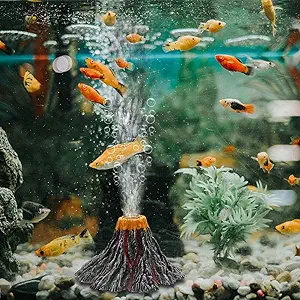Introduction
Keeping fish healthy is a top priority for aquarium enthusiasts, but sometimes, fish can become sick due to poor water conditions, infections, or other environmental factors. Recognizing the signs of a sick fish early can prevent diseases from spreading and improve recovery chances. In this guide, we will discuss the most common signs of fish illness and how to treat common fish diseases effectively.
Common Signs of a Sick Fish
1. Changes in Behavior
- Lethargy: Fish becoming unusually inactive, staying at the bottom or floating near the surface.
- Erratic Swimming: Darting, spinning, or swimming sideways could indicate neurological or swim bladder issues.
- Loss of Appetite: Refusal to eat is often a sign of illness or stress.
- Gasping at the Surface: May indicate low oxygen levels, gill damage, or ammonia poisoning.
- Scratching Against Objects: Frequent rubbing against decorations or the substrate can indicate parasites.
2. Physical Changes
- White Spots: Small white dots on fins and body, often a sign of Ich (white spot disease).
- Clamped Fins: Fins held close to the body may indicate stress or illness.
- Red or Bloody Gills: A sign of ammonia poisoning or gill infections.
- Cloudy Eyes: Can be caused by bacterial infections or poor water quality.
- Bloated Belly: May indicate dropsy, constipation, or an internal parasite.
- Fungal Growths: White, cotton-like patches on the skin or fins suggest a fungal infection.
- Ulcers or Open Sores: Wounds that don’t heal could point to bacterial infections.
How to Treat Common Fish Diseases
1. Ich (White Spot Disease)
Symptoms:
- White spots on the body, fins, and gills.
- Fish rubbing against surfaces.
- Labored breathing and lethargy.
Treatment:
- Increase the tank temperature gradually to 78-82°F (25-28°C) to speed up the parasite’s life cycle.
- Use an Ich treatment containing malachite green or formalin.
- Perform regular water changes and improve filtration.
2. Fin Rot
Symptoms:
- Fins appear ragged, torn, or frayed.
- Edges of fins may turn white or black.
- Fish may become less active.
Treatment:
- Improve water quality by performing frequent water changes.
- Treat with antibacterial medication like Maracyn or API Fin & Body Cure.
- Ensure fish are not being nipped by aggressive tank mates.
3. Swim Bladder Disease
Symptoms:
- Fish floating upside down or struggling to maintain balance.
- Difficulty swimming to the bottom or floating uncontrollably at the surface.
Treatment:
- Avoid overfeeding and offer peeled, cooked peas to relieve constipation.
- Maintain clean water with stable parameters.
- Reduce water flow to help affected fish move more easily.
Also Read:
4. Dropsy
Symptoms:
- Fish appears bloated with raised scales (pinecone effect).
- Lethargy and difficulty swimming.
- Loss of appetite.
Treatment:
- Isolate the affected fish in a hospital tank.
- Use Epsom salt (1 teaspoon per gallon) to reduce swelling.
- Administer antibiotic treatment like Kanamycin or Maracyn-Two.
5. Columnaris (Cotton Wool Disease)
Symptoms:
- White, cotton-like patches on the mouth, fins, and body.
- Frayed fins and difficulty breathing.
- Loss of color and lethargy.
Treatment:
- Treat with antibacterial medication such as Furan-2 or Kanaplex.
- Improve water conditions by performing regular water changes.
- Reduce stress by keeping the tank clean and stable.
6. Velvet Disease
Symptoms:
- Fine, gold or rust-colored dust on the fish’s body.
- Clamped fins and labored breathing.
- Scratching against objects.
Treatment:
- Use copper-based treatments like Cupramine.
- Increase water temperature slightly to speed up the parasite’s life cycle.
- Keep the aquarium in darkness for a few days as Velvet parasites rely on light.
7. Fungal Infections
Symptoms:
- White, cotton-like patches on fins or body.
- Fish appearing lethargic and losing appetite.
Treatment:
- Remove infected fish and treat with antifungal medication like Pimafix or aquarium salt.
- Keep the tank clean and ensure good water quality.
How to Prevent Fish Diseases
Maintain Good Water Quality
- Test water parameters regularly (pH, ammonia, nitrite, nitrate levels).
- Perform regular water changes (25-50% weekly, depending on bioload).
- Avoid overfeeding to reduce waste buildup.
Quarantine New Fish
- Keep new fish in a separate tank for at least 2 weeks before adding them to the main aquarium.
- Observe for any signs of disease before introducing them to the community tank.
Provide a Balanced Diet
- Feed high-quality pellets, flakes, or live/frozen foods.
- Avoid feeding excessive amounts, as uneaten food can deteriorate water quality.
Reduce Stress Factors
- Maintain stable temperature and pH levels.
- Avoid overcrowding the tank.
- Provide hiding places and proper tankmates to prevent aggression.
Conclusion
Identifying the signs of a sick fish early can make a huge difference in their recovery. By maintaining good water quality, providing proper nutrition, and treating illnesses promptly, you can keep your fish healthy and thriving. Always monitor your fish closely and take immediate action if you notice any signs of illness.
Do you have any questions or personal experiences dealing with fish diseases? Share them in the comments below!


















Add comment